Primary Health Care and Nursing Practice: Assignment Solutions
VerifiedAdded on 2020/06/05
|17
|4005
|445
Homework Assignment
AI Summary
This document presents a comprehensive solution to a nursing assignment focused on primary health care. It begins by defining the philosophical tenets underpinning primary health care, followed by an analysis of health challenges in Australia, including diseases, funding issues, and environmental concerns. The assignment addresses common health issues across different age groups (infants, children, adolescents, adults, and older people) and explores specific health challenges faced by Aboriginal and Torres Strait Islander peoples. It also covers resources for managing diabetes and dementia, discusses the health-illness continuum, and outlines the roles of key organizations like APNA and NPHCP. The document further examines patient safety, contributions of the Australian Journal of Primary Health, and practical strategies for caring for confused individuals. It differentiates between preventive, curative, and rehabilitative service models, provides examples of resources, and describes trans-disciplinary care. Finally, it explores the application of principles like access and equity, empowerment, and provides a detailed case study on first aid management for a patient experiencing chest pain.
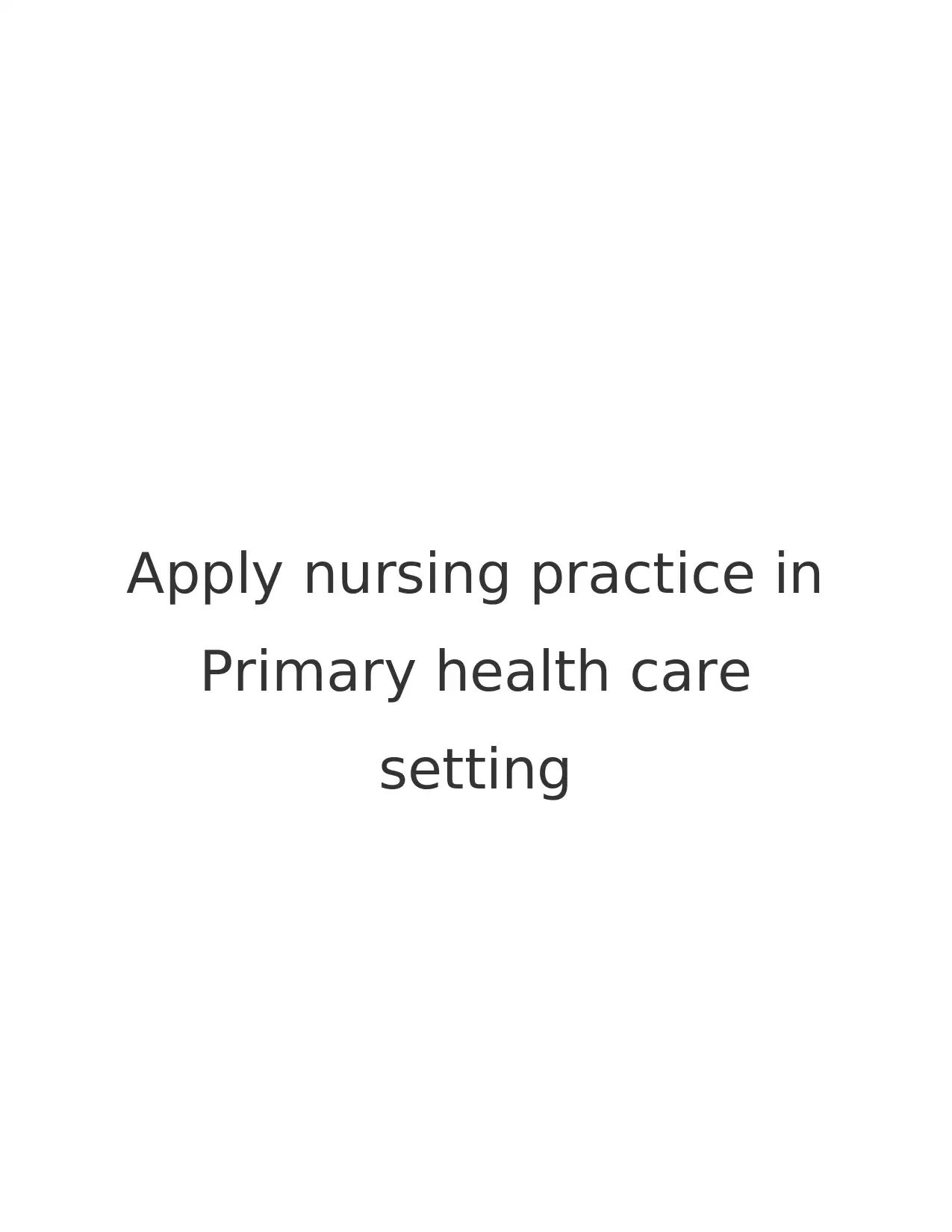
Apply nursing practice in
Primary health care
setting
Primary health care
setting
Paraphrase This Document
Need a fresh take? Get an instant paraphrase of this document with our AI Paraphraser
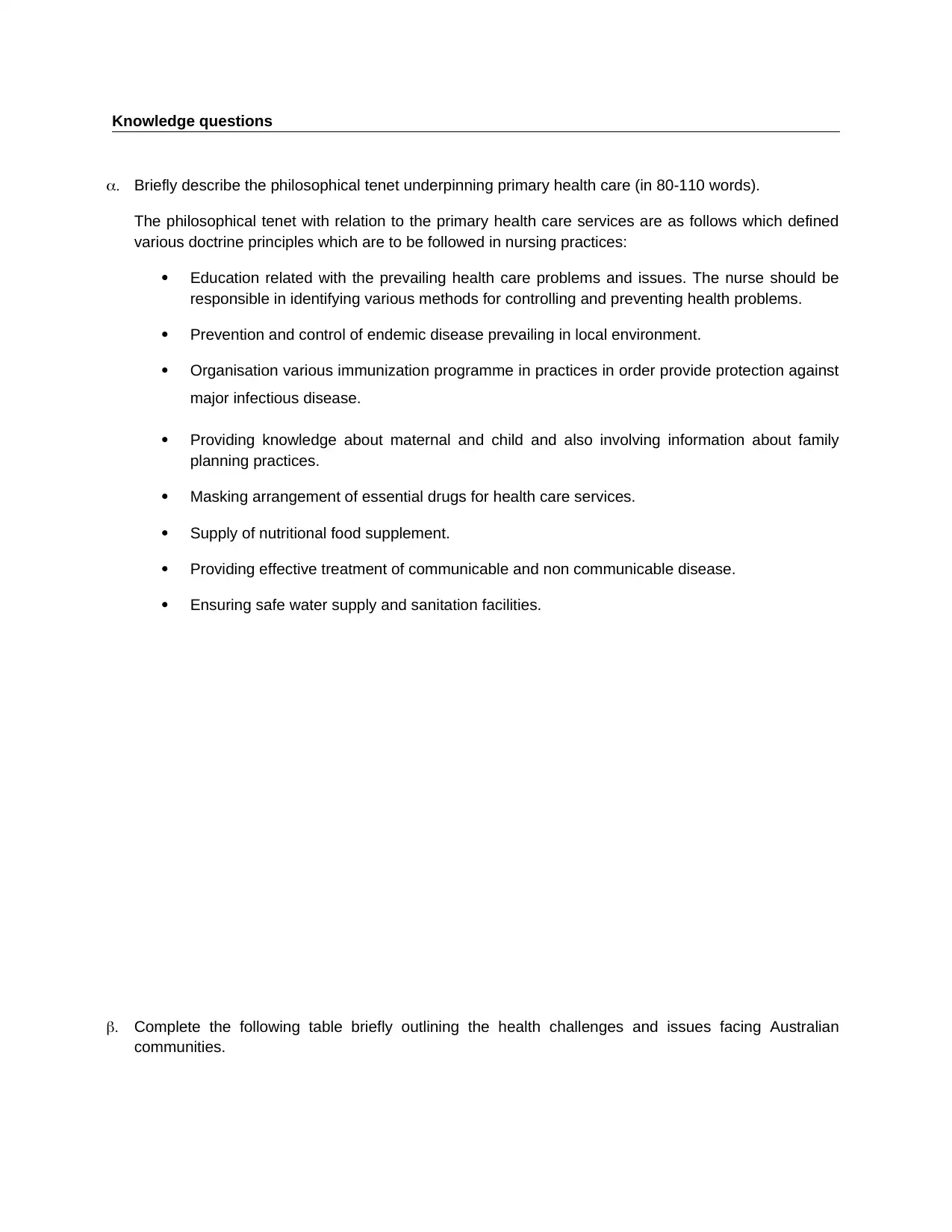
Knowledge questions
a. Briefly describe the philosophical tenet underpinning primary health care (in 80-110 words).
The philosophical tenet with relation to the primary health care services are as follows which defined
various doctrine principles which are to be followed in nursing practices:
Education related with the prevailing health care problems and issues. The nurse should be
responsible in identifying various methods for controlling and preventing health problems.
Prevention and control of endemic disease prevailing in local environment.
Organisation various immunization programme in practices in order provide protection against
major infectious disease.
Providing knowledge about maternal and child and also involving information about family
planning practices.
Masking arrangement of essential drugs for health care services.
Supply of nutritional food supplement.
Providing effective treatment of communicable and non communicable disease.
Ensuring safe water supply and sanitation facilities.
b. Complete the following table briefly outlining the health challenges and issues facing Australian
communities.
a. Briefly describe the philosophical tenet underpinning primary health care (in 80-110 words).
The philosophical tenet with relation to the primary health care services are as follows which defined
various doctrine principles which are to be followed in nursing practices:
Education related with the prevailing health care problems and issues. The nurse should be
responsible in identifying various methods for controlling and preventing health problems.
Prevention and control of endemic disease prevailing in local environment.
Organisation various immunization programme in practices in order provide protection against
major infectious disease.
Providing knowledge about maternal and child and also involving information about family
planning practices.
Masking arrangement of essential drugs for health care services.
Supply of nutritional food supplement.
Providing effective treatment of communicable and non communicable disease.
Ensuring safe water supply and sanitation facilities.
b. Complete the following table briefly outlining the health challenges and issues facing Australian
communities.

Requirements Responses
ii) Nine (9) diseases
and conditions that
contribute significantly to
the burden of illness and
injury in the Australian
community with
reference to the National
Health Priority Areas.
1. cardiovascular health issues: These are the issues or disease
related with the vascular and cardiac system of body. This involves the
heart damage, cardiac stroke etc.
2. Cancerous diseases: The cancer may develop inn individual body
because of mutation in oncogene which results in faster division of cells
in body and accumulation of cells in the body. This may restricts the
effective working of nearby organs.
3. Injury prevention and control measures: This can be because of
any accident or cut on skin. Blood flows outside from the injured part.
The injury may be external which can be seen while the internal injuries
are damage to the internal organs of bodies.
4. Mental disease: This can be defined as damage to brain cells or ill
functioning of brain which leads to many symptoms affecting the proper
working of brain in body.
5. Diabetes Mellitus: This is cased because of hypertension and the
higher level of stress. Another region of development of diabetes may
be obesity. The sugar level imbalance can be observed in patient of
diabetes.
6. Asthma: This is related with the respiratory system disease.
7. Obesity
8. Arthritis
9. Dementia
iii) Four (4) other
health challenges facing
Australian communities
(Hint: Health challenges
in relation to the
resource allocation,
funding and delivery of
health care.
The major challenged faced by Australian communities in health acre
services are as follows:
1. Funding of private and public health care services in Australia.
2. Health inequality issues.
3. Technology and resource costs.
4. The issues related with rapid urbanisation in country.
Satisfactory Not Yet Satisfactory
iv) Any three (3)
environmental health
issues facing Australian
communities.
Due to mineral dust Asbestosis may develop.
Asthma may develop because of air pollution.
ii) Nine (9) diseases
and conditions that
contribute significantly to
the burden of illness and
injury in the Australian
community with
reference to the National
Health Priority Areas.
1. cardiovascular health issues: These are the issues or disease
related with the vascular and cardiac system of body. This involves the
heart damage, cardiac stroke etc.
2. Cancerous diseases: The cancer may develop inn individual body
because of mutation in oncogene which results in faster division of cells
in body and accumulation of cells in the body. This may restricts the
effective working of nearby organs.
3. Injury prevention and control measures: This can be because of
any accident or cut on skin. Blood flows outside from the injured part.
The injury may be external which can be seen while the internal injuries
are damage to the internal organs of bodies.
4. Mental disease: This can be defined as damage to brain cells or ill
functioning of brain which leads to many symptoms affecting the proper
working of brain in body.
5. Diabetes Mellitus: This is cased because of hypertension and the
higher level of stress. Another region of development of diabetes may
be obesity. The sugar level imbalance can be observed in patient of
diabetes.
6. Asthma: This is related with the respiratory system disease.
7. Obesity
8. Arthritis
9. Dementia
iii) Four (4) other
health challenges facing
Australian communities
(Hint: Health challenges
in relation to the
resource allocation,
funding and delivery of
health care.
The major challenged faced by Australian communities in health acre
services are as follows:
1. Funding of private and public health care services in Australia.
2. Health inequality issues.
3. Technology and resource costs.
4. The issues related with rapid urbanisation in country.
Satisfactory Not Yet Satisfactory
iv) Any three (3)
environmental health
issues facing Australian
communities.
Due to mineral dust Asbestosis may develop.
Asthma may develop because of air pollution.
⊘ This is a preview!⊘
Do you want full access?
Subscribe today to unlock all pages.

Trusted by 1+ million students worldwide
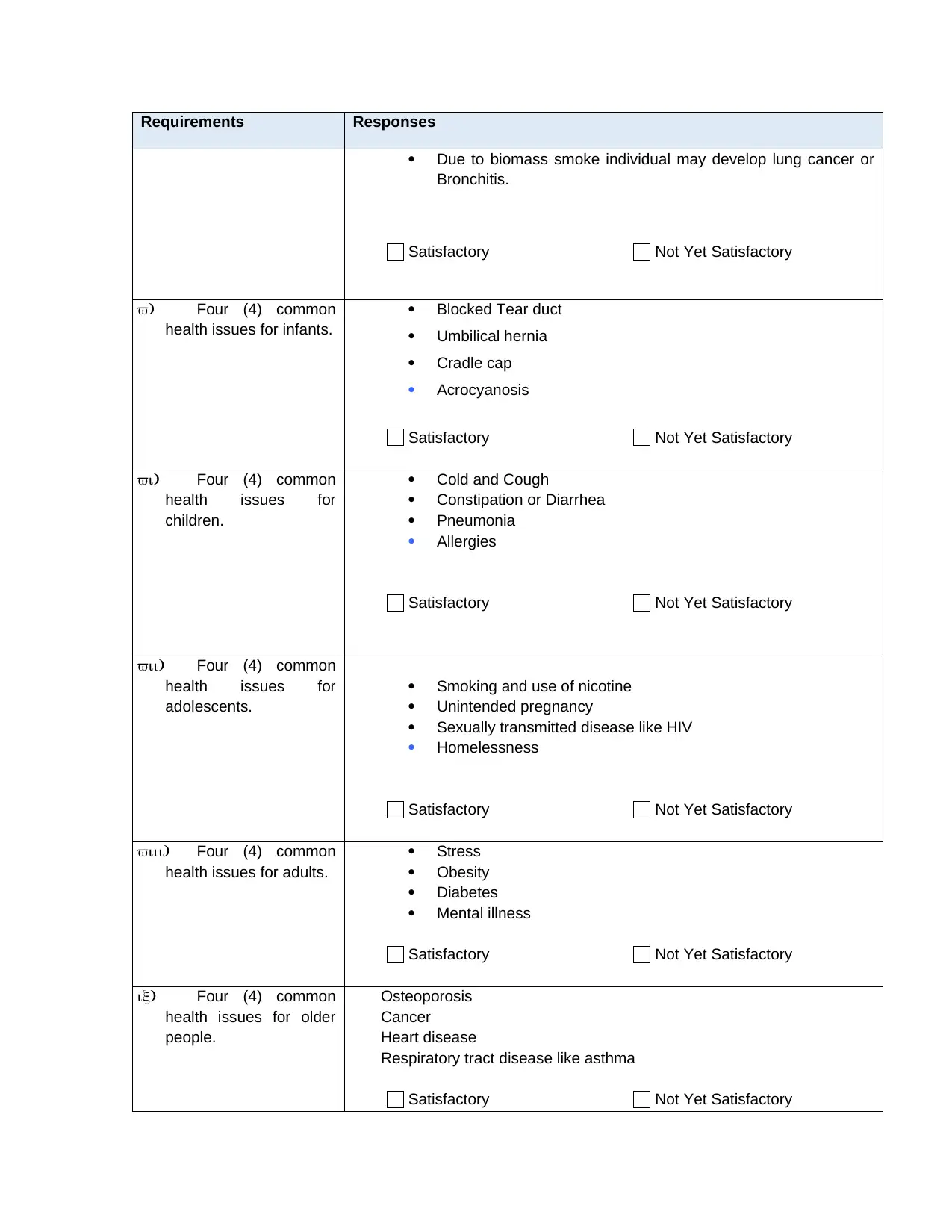
Requirements Responses
Due to biomass smoke individual may develop lung cancer or
Bronchitis.
Satisfactory Not Yet Satisfactory
v) Four (4) common
health issues for infants.
Blocked Tear duct
Umbilical hernia
Cradle cap
Acrocyanosis
Satisfactory Not Yet Satisfactory
vi) Four (4) common
health issues for
children.
Cold and Cough
Constipation or Diarrhea
Pneumonia
Allergies
Satisfactory Not Yet Satisfactory
vii) Four (4) common
health issues for
adolescents.
Smoking and use of nicotine
Unintended pregnancy
Sexually transmitted disease like HIV
Homelessness
Satisfactory Not Yet Satisfactory
viii) Four (4) common
health issues for adults.
Stress
Obesity
Diabetes
Mental illness
Satisfactory Not Yet Satisfactory
ix) Four (4) common
health issues for older
people.
Osteoporosis
Cancer
Heart disease
Respiratory tract disease like asthma
Satisfactory Not Yet Satisfactory
Due to biomass smoke individual may develop lung cancer or
Bronchitis.
Satisfactory Not Yet Satisfactory
v) Four (4) common
health issues for infants.
Blocked Tear duct
Umbilical hernia
Cradle cap
Acrocyanosis
Satisfactory Not Yet Satisfactory
vi) Four (4) common
health issues for
children.
Cold and Cough
Constipation or Diarrhea
Pneumonia
Allergies
Satisfactory Not Yet Satisfactory
vii) Four (4) common
health issues for
adolescents.
Smoking and use of nicotine
Unintended pregnancy
Sexually transmitted disease like HIV
Homelessness
Satisfactory Not Yet Satisfactory
viii) Four (4) common
health issues for adults.
Stress
Obesity
Diabetes
Mental illness
Satisfactory Not Yet Satisfactory
ix) Four (4) common
health issues for older
people.
Osteoporosis
Cancer
Heart disease
Respiratory tract disease like asthma
Satisfactory Not Yet Satisfactory
Paraphrase This Document
Need a fresh take? Get an instant paraphrase of this document with our AI Paraphraser
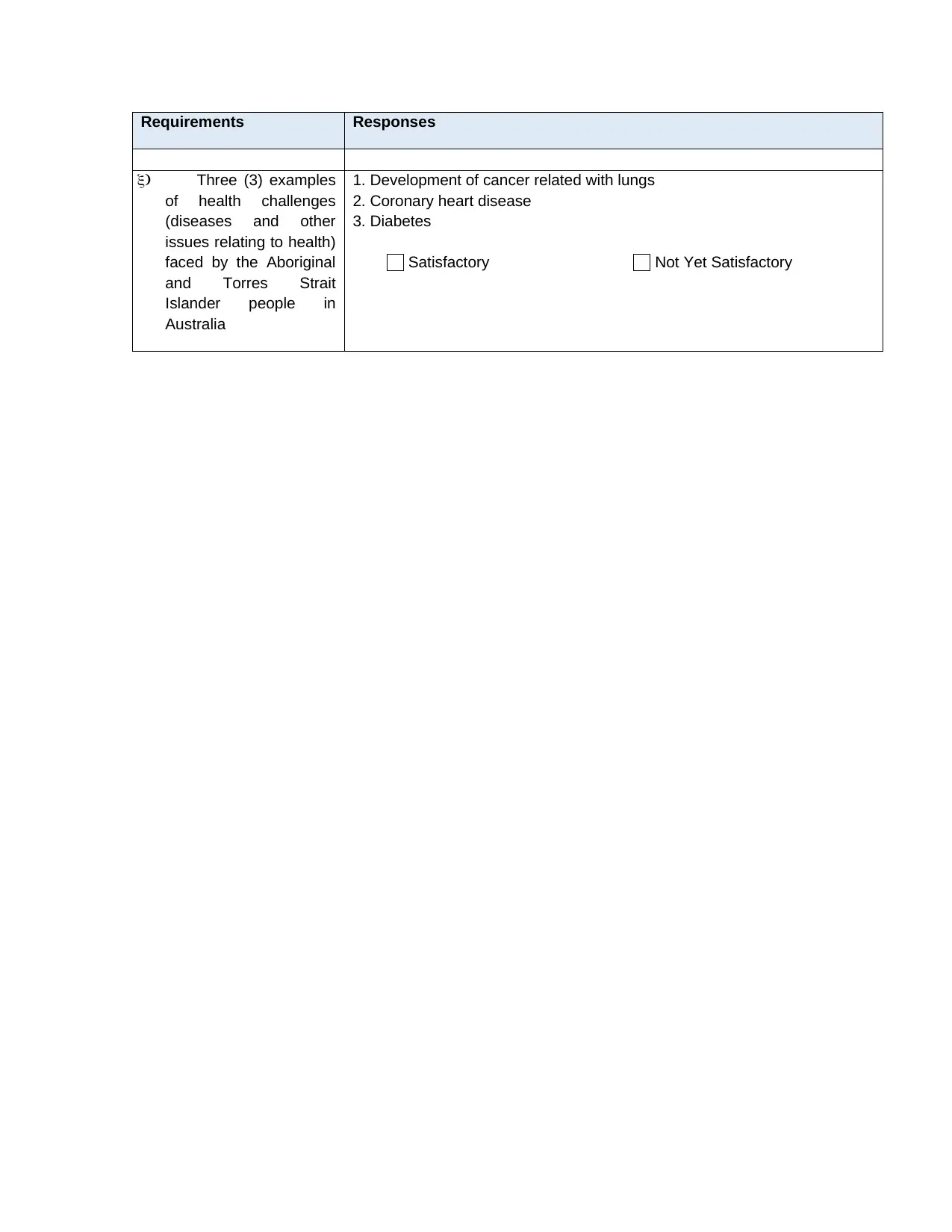
Requirements Responses
x) Three (3) examples
of health challenges
(diseases and other
issues relating to health)
faced by the Aboriginal
and Torres Strait
Islander people in
Australia
1. Development of cancer related with lungs
2. Coronary heart disease
3. Diabetes
Satisfactory Not Yet Satisfactory
x) Three (3) examples
of health challenges
(diseases and other
issues relating to health)
faced by the Aboriginal
and Torres Strait
Islander people in
Australia
1. Development of cancer related with lungs
2. Coronary heart disease
3. Diabetes
Satisfactory Not Yet Satisfactory
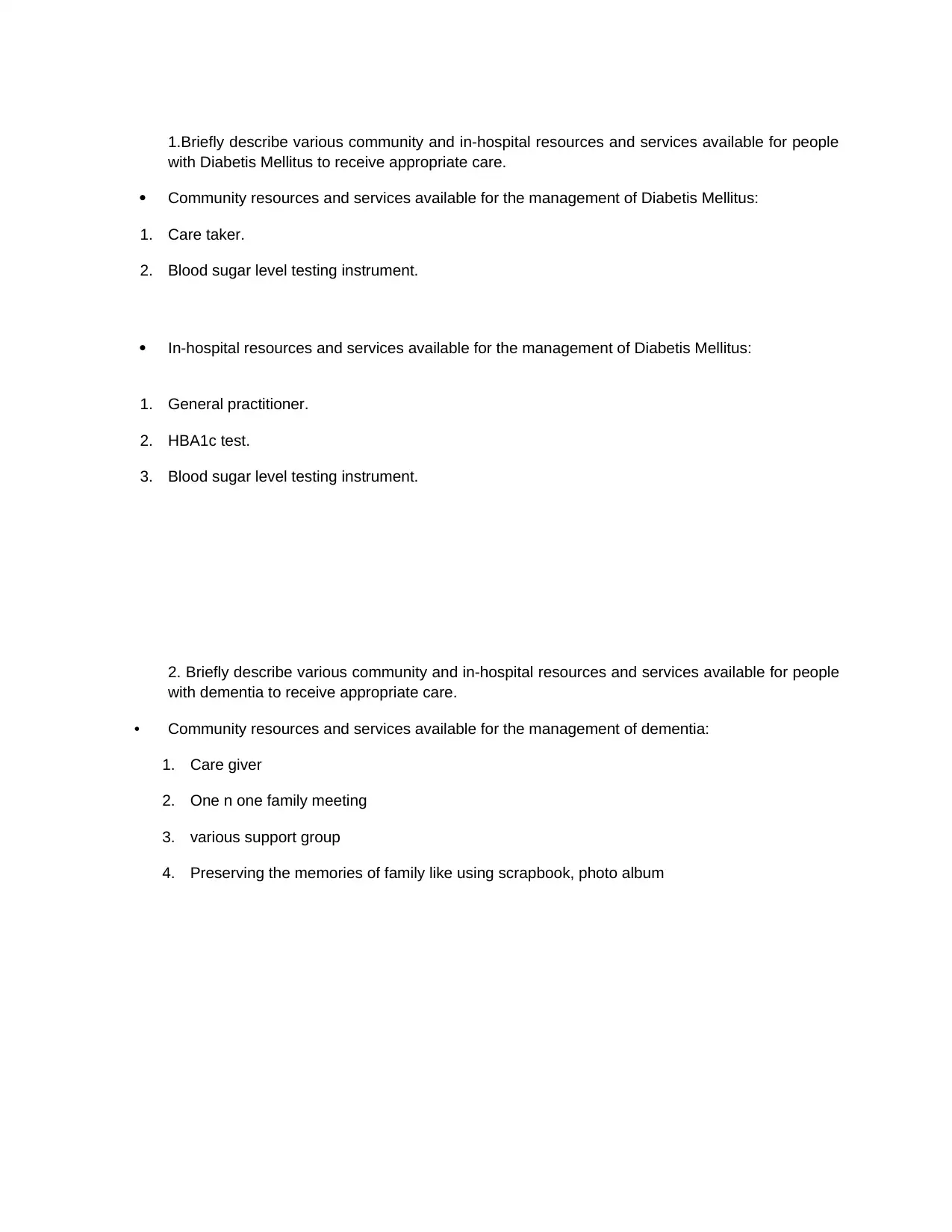
1.Briefly describe various community and in-hospital resources and services available for people
with Diabetis Mellitus to receive appropriate care.
Community resources and services available for the management of Diabetis Mellitus:
1. Care taker.
2. Blood sugar level testing instrument.
In-hospital resources and services available for the management of Diabetis Mellitus:
1. General practitioner.
2. HBA1c test.
3. Blood sugar level testing instrument.
2. Briefly describe various community and in-hospital resources and services available for people
with dementia to receive appropriate care.
• Community resources and services available for the management of dementia:
1. Care giver
2. One n one family meeting
3. various support group
4. Preserving the memories of family like using scrapbook, photo album
with Diabetis Mellitus to receive appropriate care.
Community resources and services available for the management of Diabetis Mellitus:
1. Care taker.
2. Blood sugar level testing instrument.
In-hospital resources and services available for the management of Diabetis Mellitus:
1. General practitioner.
2. HBA1c test.
3. Blood sugar level testing instrument.
2. Briefly describe various community and in-hospital resources and services available for people
with dementia to receive appropriate care.
• Community resources and services available for the management of dementia:
1. Care giver
2. One n one family meeting
3. various support group
4. Preserving the memories of family like using scrapbook, photo album
⊘ This is a preview!⊘
Do you want full access?
Subscribe today to unlock all pages.

Trusted by 1+ million students worldwide

• In-hospital resources and services available for the management of dementia:
1. Doctor
2. Nurses assistance
3. Electroneurogram
4. CT scan
5 Briefly describe the health-illness continuum (illness-wellness continuum) (in 70-100 words).
This is wellness pi-diagram which is developed in order to analysis the health condition of the
patient. The nurse continuously access the changing condition of patient through using this health illness
continuum ((Melnyk and Fineout-Overholt, 2011)). The nurse check the health of person whether
individual is recovering from disease or getting more ill. The higher level of health can develop through
providing awareness about illness then then educationist and growth to the health care. While the
individual gives towards premature death due to failure of accessing the early signs of illness, symptoms
of disease and disability which leads to the death of person.
6. Briefly describe the roles of the following two (2) primary health care organisations.
a. Australian Primary Health Care Nurses Association (in 40-70 words):
ANS: APNA is the pinnacle proficient body for medical attendants working in essential social insurance
including general practice. ... APNA constantly endeavours to build familiarity with the part of the essential
human services nurture, and to be dynamic and energetic association for its individuals.
\
b. National Primary Health Care Partnership (NPHCP) (in 50-80 words):
ANS:The NPHCP in speaking to such an expansive scope of essential medicinal services experts is
focused on a complete essential social insurance framework that addresses the issues of the Australian
people group.
7. Refer to the Patient Safety in Primary Health Care - a review of the literature 2015 published by the
Australian Commission on Safety and Quality in Health Care (ACSQHC) and identify the purpose of
this document (in 20-40 words).
ANS: A scope of research strategies is the ideal method for examining persistent security episodes in
essential human services. Episode revealing and learning frameworks convey rich detail and setting
about patient health episodes and offer clinicians a chance to create rehearse change.
8. Briefly describe how the Australian Journal of Primary Health contributes to the information relevant to
primary health care (in 70-100 words).
1. Doctor
2. Nurses assistance
3. Electroneurogram
4. CT scan
5 Briefly describe the health-illness continuum (illness-wellness continuum) (in 70-100 words).
This is wellness pi-diagram which is developed in order to analysis the health condition of the
patient. The nurse continuously access the changing condition of patient through using this health illness
continuum ((Melnyk and Fineout-Overholt, 2011)). The nurse check the health of person whether
individual is recovering from disease or getting more ill. The higher level of health can develop through
providing awareness about illness then then educationist and growth to the health care. While the
individual gives towards premature death due to failure of accessing the early signs of illness, symptoms
of disease and disability which leads to the death of person.
6. Briefly describe the roles of the following two (2) primary health care organisations.
a. Australian Primary Health Care Nurses Association (in 40-70 words):
ANS: APNA is the pinnacle proficient body for medical attendants working in essential social insurance
including general practice. ... APNA constantly endeavours to build familiarity with the part of the essential
human services nurture, and to be dynamic and energetic association for its individuals.
\
b. National Primary Health Care Partnership (NPHCP) (in 50-80 words):
ANS:The NPHCP in speaking to such an expansive scope of essential medicinal services experts is
focused on a complete essential social insurance framework that addresses the issues of the Australian
people group.
7. Refer to the Patient Safety in Primary Health Care - a review of the literature 2015 published by the
Australian Commission on Safety and Quality in Health Care (ACSQHC) and identify the purpose of
this document (in 20-40 words).
ANS: A scope of research strategies is the ideal method for examining persistent security episodes in
essential human services. Episode revealing and learning frameworks convey rich detail and setting
about patient health episodes and offer clinicians a chance to create rehearse change.
8. Briefly describe how the Australian Journal of Primary Health contributes to the information relevant to
primary health care (in 70-100 words).
Paraphrase This Document
Need a fresh take? Get an instant paraphrase of this document with our AI Paraphraser

ANS: This specific diary gets coordination the elements of group and essential medicinal services benefits
and interlinking different hypotheses related with health and social services (Sangster‐Gormley and et. al.,
2011). The Australian diary of Primary wellbeing build up an examination which is peer audited and top
notch data with connection to topic. This specific diary completed an extreme investigation about the
different elements influencing essential social insurance administrations and practices of group health
administrations. This specific did clinical focused practices however avoids the majority of the branch of
knowledge of clinical intercession.
and interlinking different hypotheses related with health and social services (Sangster‐Gormley and et. al.,
2011). The Australian diary of Primary wellbeing build up an examination which is peer audited and top
notch data with connection to topic. This specific diary completed an extreme investigation about the
different elements influencing essential social insurance administrations and practices of group health
administrations. This specific did clinical focused practices however avoids the majority of the branch of
knowledge of clinical intercession.
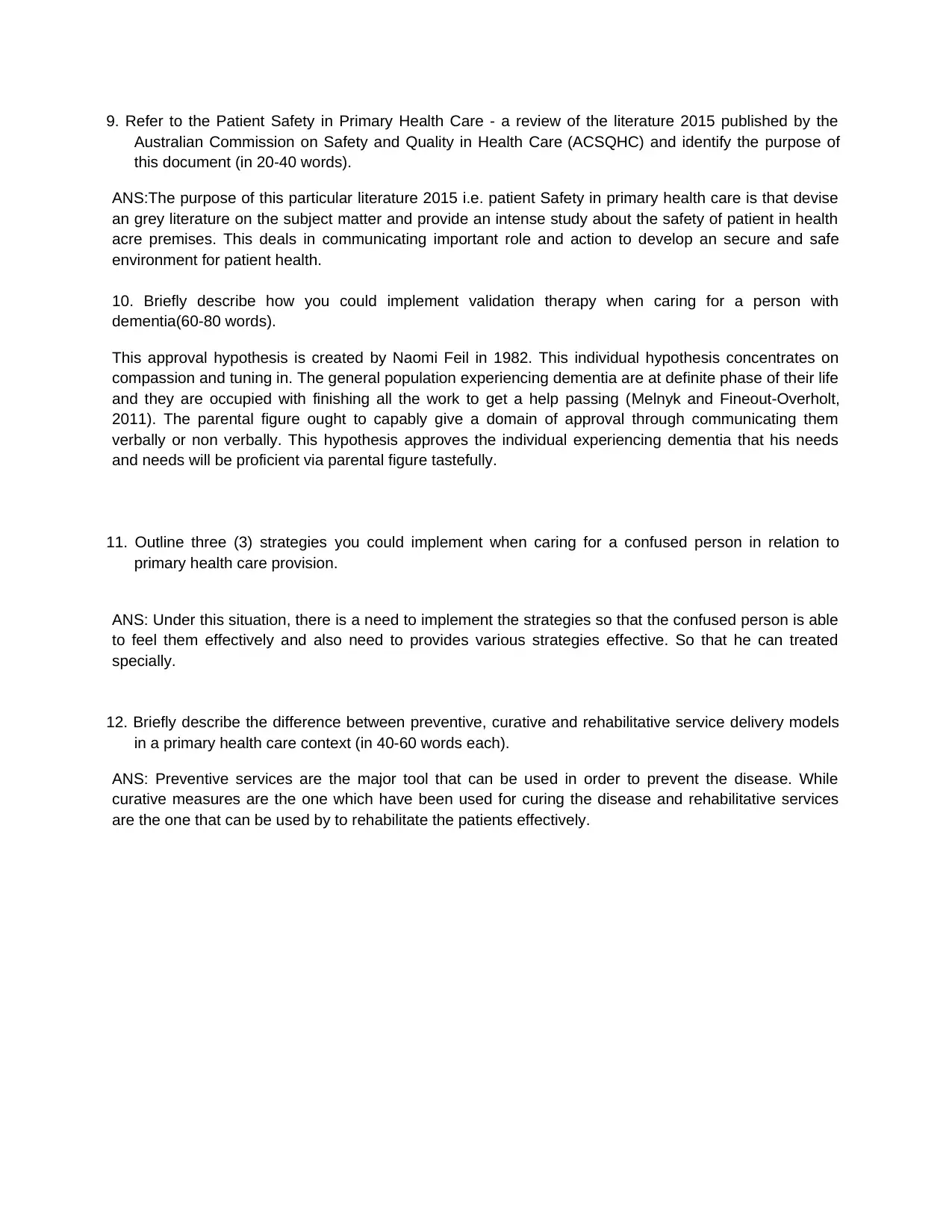
9. Refer to the Patient Safety in Primary Health Care - a review of the literature 2015 published by the
Australian Commission on Safety and Quality in Health Care (ACSQHC) and identify the purpose of
this document (in 20-40 words).
ANS:The purpose of this particular literature 2015 i.e. patient Safety in primary health care is that devise
an grey literature on the subject matter and provide an intense study about the safety of patient in health
acre premises. This deals in communicating important role and action to develop an secure and safe
environment for patient health.
10. Briefly describe how you could implement validation therapy when caring for a person with
dementia(60-80 words).
This approval hypothesis is created by Naomi Feil in 1982. This individual hypothesis concentrates on
compassion and tuning in. The general population experiencing dementia are at definite phase of their life
and they are occupied with finishing all the work to get a help passing (Melnyk and Fineout-Overholt,
2011). The parental figure ought to capably give a domain of approval through communicating them
verbally or non verbally. This hypothesis approves the individual experiencing dementia that his needs
and needs will be proficient via parental figure tastefully.
11. Outline three (3) strategies you could implement when caring for a confused person in relation to
primary health care provision.
ANS: Under this situation, there is a need to implement the strategies so that the confused person is able
to feel them effectively and also need to provides various strategies effective. So that he can treated
specially.
12. Briefly describe the difference between preventive, curative and rehabilitative service delivery models
in a primary health care context (in 40-60 words each).
ANS: Preventive services are the major tool that can be used in order to prevent the disease. While
curative measures are the one which have been used for curing the disease and rehabilitative services
are the one that can be used by to rehabilitate the patients effectively.
Australian Commission on Safety and Quality in Health Care (ACSQHC) and identify the purpose of
this document (in 20-40 words).
ANS:The purpose of this particular literature 2015 i.e. patient Safety in primary health care is that devise
an grey literature on the subject matter and provide an intense study about the safety of patient in health
acre premises. This deals in communicating important role and action to develop an secure and safe
environment for patient health.
10. Briefly describe how you could implement validation therapy when caring for a person with
dementia(60-80 words).
This approval hypothesis is created by Naomi Feil in 1982. This individual hypothesis concentrates on
compassion and tuning in. The general population experiencing dementia are at definite phase of their life
and they are occupied with finishing all the work to get a help passing (Melnyk and Fineout-Overholt,
2011). The parental figure ought to capably give a domain of approval through communicating them
verbally or non verbally. This hypothesis approves the individual experiencing dementia that his needs
and needs will be proficient via parental figure tastefully.
11. Outline three (3) strategies you could implement when caring for a confused person in relation to
primary health care provision.
ANS: Under this situation, there is a need to implement the strategies so that the confused person is able
to feel them effectively and also need to provides various strategies effective. So that he can treated
specially.
12. Briefly describe the difference between preventive, curative and rehabilitative service delivery models
in a primary health care context (in 40-60 words each).
ANS: Preventive services are the major tool that can be used in order to prevent the disease. While
curative measures are the one which have been used for curing the disease and rehabilitative services
are the one that can be used by to rehabilitate the patients effectively.
⊘ This is a preview!⊘
Do you want full access?
Subscribe today to unlock all pages.

Trusted by 1+ million students worldwide

13. Provide an example each for the resources available in Australia for the provision of preventive,
curative and rehabilitative service delivery models.
Ans: there is a need to have acute care services in an effective manner so that provision of preventive,
curative and rehabilitative services are required to be done. Under acute services, there are various
services: emergency care, urgent care, trauma care, short term stabilization, pre-hospital care, critical
care, short- term stabilization care (Lillis and et. al., 2010). These are the ways by which these can be
overcome by applying provision of preventive, curative and rehabilitative service delivery models.
14. Briefly describe the model of trans-disciplinary care in a primary health care context (in 50-80 words).
Ans: This is the main examination to deliberately survey the accessible distributed writing portraying
inventive models of exhaustive essential social insurance (PHC) in provincial and remote Australia since
the advancement of the principal National Rural Health Strategy (1993– 2006). The examination expected
to portray what wellbeing administration models were accounted for to work, where they worked and why.
15. Briefly describe how you would apply or promote the following principles in a primary health care
context (in 40-70 words each).
c. Access and equity
Ans: Medical caretakers and maternity specialists perceive the assorted variety of individuals constituting
Australian culture, including migrants, haven searchers, evacuees, and prisoners; and the duty of medical
caretakers furthermore, maternity specialists to give simply, empathetic, socially equipped, and socially
conscious furthermore, responsive care to every last individual requiring or getting care (Goodman and
Schorling, 2012).
d. Empowerment:
Ans: There is need to make empowerment in the society . Empowerment and strengthening of both staff
and group was a key necessity for progress recognized in many ventures. This engagement and
strengthening was fundamental for compelling cooperation and exact needs appraisal.
curative and rehabilitative service delivery models.
Ans: there is a need to have acute care services in an effective manner so that provision of preventive,
curative and rehabilitative services are required to be done. Under acute services, there are various
services: emergency care, urgent care, trauma care, short term stabilization, pre-hospital care, critical
care, short- term stabilization care (Lillis and et. al., 2010). These are the ways by which these can be
overcome by applying provision of preventive, curative and rehabilitative service delivery models.
14. Briefly describe the model of trans-disciplinary care in a primary health care context (in 50-80 words).
Ans: This is the main examination to deliberately survey the accessible distributed writing portraying
inventive models of exhaustive essential social insurance (PHC) in provincial and remote Australia since
the advancement of the principal National Rural Health Strategy (1993– 2006). The examination expected
to portray what wellbeing administration models were accounted for to work, where they worked and why.
15. Briefly describe how you would apply or promote the following principles in a primary health care
context (in 40-70 words each).
c. Access and equity
Ans: Medical caretakers and maternity specialists perceive the assorted variety of individuals constituting
Australian culture, including migrants, haven searchers, evacuees, and prisoners; and the duty of medical
caretakers furthermore, maternity specialists to give simply, empathetic, socially equipped, and socially
conscious furthermore, responsive care to every last individual requiring or getting care (Goodman and
Schorling, 2012).
d. Empowerment:
Ans: There is need to make empowerment in the society . Empowerment and strengthening of both staff
and group was a key necessity for progress recognized in many ventures. This engagement and
strengthening was fundamental for compelling cooperation and exact needs appraisal.
Paraphrase This Document
Need a fresh take? Get an instant paraphrase of this document with our AI Paraphraser
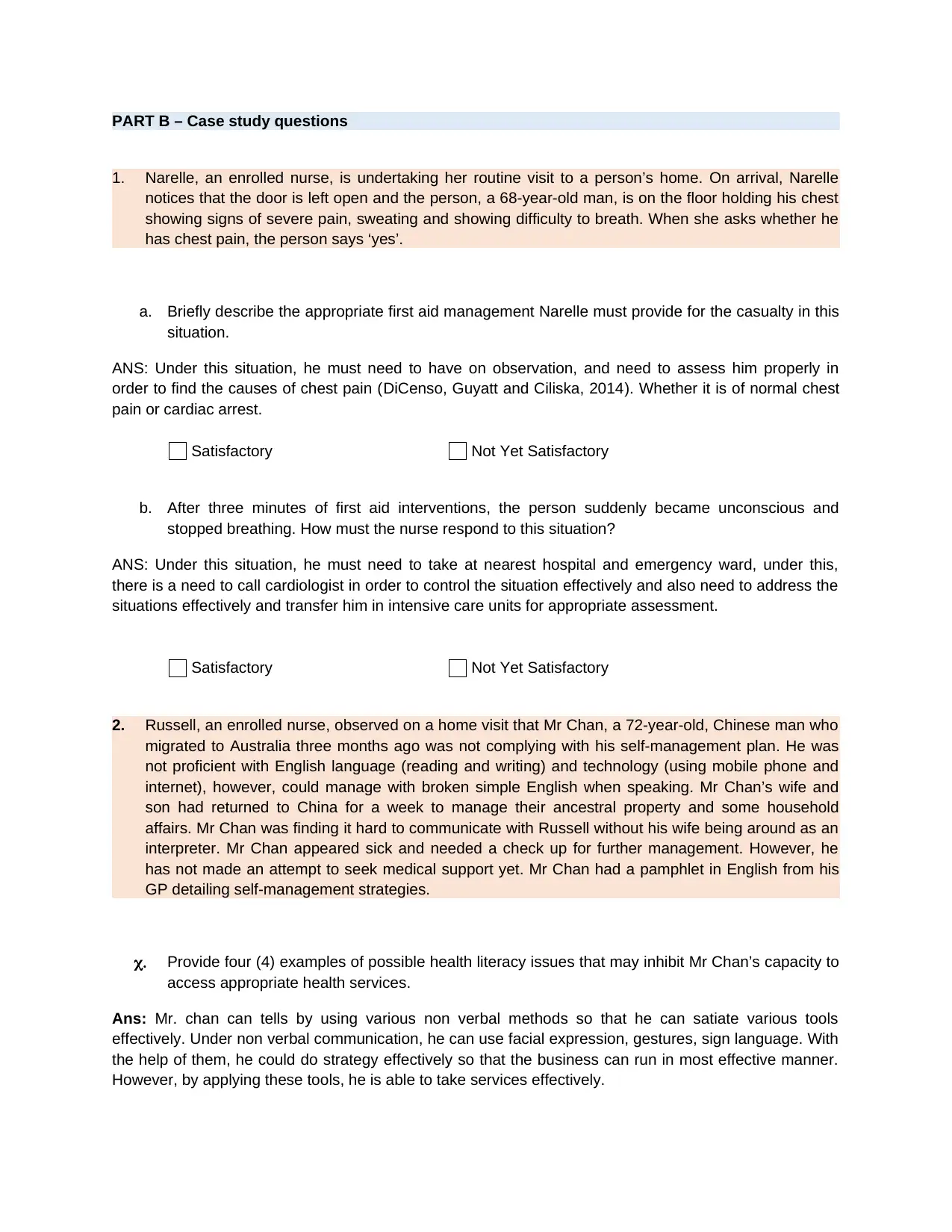
PART B – Case study questions
1. Narelle, an enrolled nurse, is undertaking her routine visit to a person’s home. On arrival, Narelle
notices that the door is left open and the person, a 68-year-old man, is on the floor holding his chest
showing signs of severe pain, sweating and showing difficulty to breath. When she asks whether he
has chest pain, the person says ‘yes’.
a. Briefly describe the appropriate first aid management Narelle must provide for the casualty in this
situation.
ANS: Under this situation, he must need to have on observation, and need to assess him properly in
order to find the causes of chest pain (DiCenso, Guyatt and Ciliska, 2014). Whether it is of normal chest
pain or cardiac arrest.
Satisfactory Not Yet Satisfactory
b. After three minutes of first aid interventions, the person suddenly became unconscious and
stopped breathing. How must the nurse respond to this situation?
ANS: Under this situation, he must need to take at nearest hospital and emergency ward, under this,
there is a need to call cardiologist in order to control the situation effectively and also need to address the
situations effectively and transfer him in intensive care units for appropriate assessment.
Satisfactory Not Yet Satisfactory
2. Russell, an enrolled nurse, observed on a home visit that Mr Chan, a 72-year-old, Chinese man who
migrated to Australia three months ago was not complying with his self-management plan. He was
not proficient with English language (reading and writing) and technology (using mobile phone and
internet), however, could manage with broken simple English when speaking. Mr Chan’s wife and
son had returned to China for a week to manage their ancestral property and some household
affairs. Mr Chan was finding it hard to communicate with Russell without his wife being around as an
interpreter. Mr Chan appeared sick and needed a check up for further management. However, he
has not made an attempt to seek medical support yet. Mr Chan had a pamphlet in English from his
GP detailing self-management strategies.
c. Provide four (4) examples of possible health literacy issues that may inhibit Mr Chan’s capacity to
access appropriate health services.
Ans: Mr. chan can tells by using various non verbal methods so that he can satiate various tools
effectively. Under non verbal communication, he can use facial expression, gestures, sign language. With
the help of them, he could do strategy effectively so that the business can run in most effective manner.
However, by applying these tools, he is able to take services effectively.
1. Narelle, an enrolled nurse, is undertaking her routine visit to a person’s home. On arrival, Narelle
notices that the door is left open and the person, a 68-year-old man, is on the floor holding his chest
showing signs of severe pain, sweating and showing difficulty to breath. When she asks whether he
has chest pain, the person says ‘yes’.
a. Briefly describe the appropriate first aid management Narelle must provide for the casualty in this
situation.
ANS: Under this situation, he must need to have on observation, and need to assess him properly in
order to find the causes of chest pain (DiCenso, Guyatt and Ciliska, 2014). Whether it is of normal chest
pain or cardiac arrest.
Satisfactory Not Yet Satisfactory
b. After three minutes of first aid interventions, the person suddenly became unconscious and
stopped breathing. How must the nurse respond to this situation?
ANS: Under this situation, he must need to take at nearest hospital and emergency ward, under this,
there is a need to call cardiologist in order to control the situation effectively and also need to address the
situations effectively and transfer him in intensive care units for appropriate assessment.
Satisfactory Not Yet Satisfactory
2. Russell, an enrolled nurse, observed on a home visit that Mr Chan, a 72-year-old, Chinese man who
migrated to Australia three months ago was not complying with his self-management plan. He was
not proficient with English language (reading and writing) and technology (using mobile phone and
internet), however, could manage with broken simple English when speaking. Mr Chan’s wife and
son had returned to China for a week to manage their ancestral property and some household
affairs. Mr Chan was finding it hard to communicate with Russell without his wife being around as an
interpreter. Mr Chan appeared sick and needed a check up for further management. However, he
has not made an attempt to seek medical support yet. Mr Chan had a pamphlet in English from his
GP detailing self-management strategies.
c. Provide four (4) examples of possible health literacy issues that may inhibit Mr Chan’s capacity to
access appropriate health services.
Ans: Mr. chan can tells by using various non verbal methods so that he can satiate various tools
effectively. Under non verbal communication, he can use facial expression, gestures, sign language. With
the help of them, he could do strategy effectively so that the business can run in most effective manner.
However, by applying these tools, he is able to take services effectively.
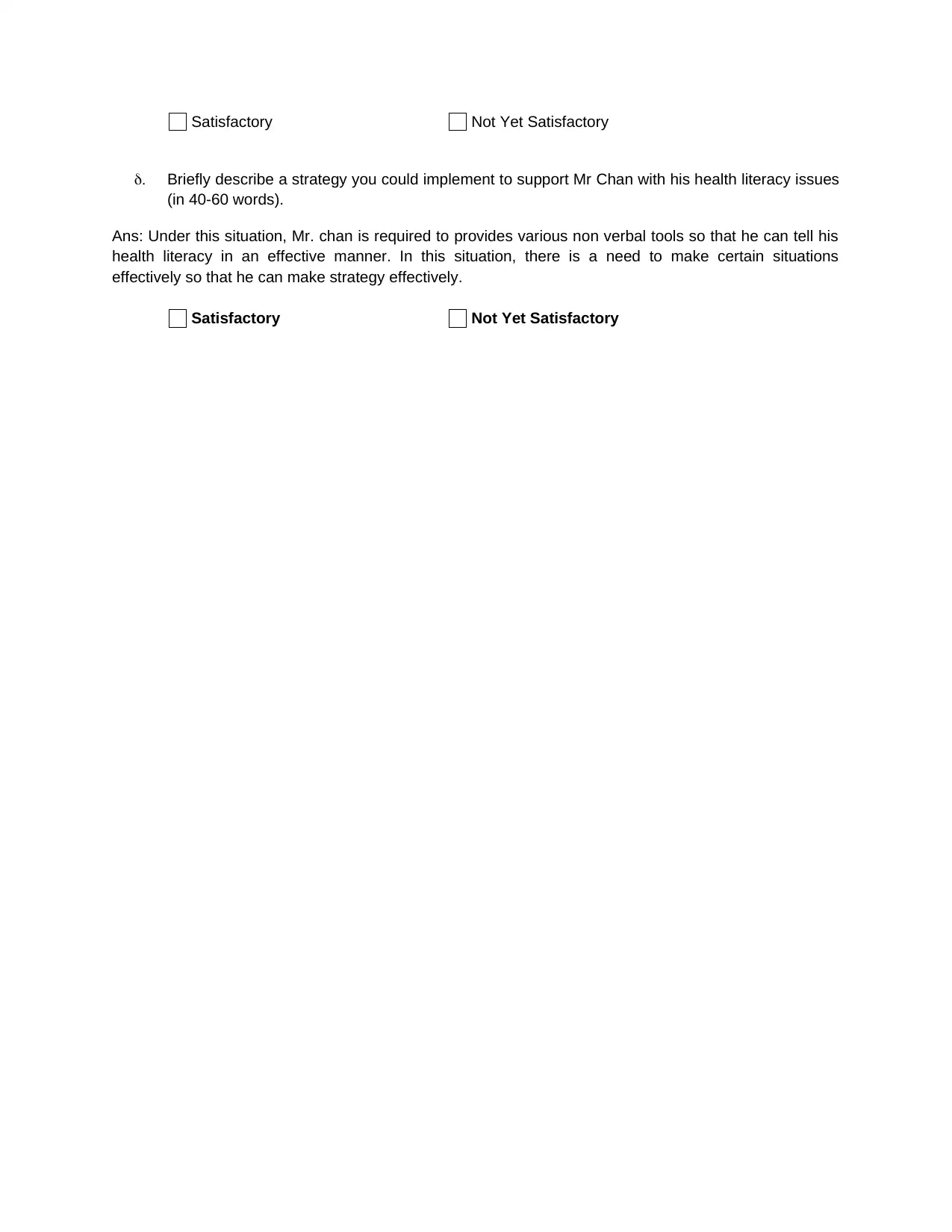
Satisfactory Not Yet Satisfactory
d. Briefly describe a strategy you could implement to support Mr Chan with his health literacy issues
(in 40-60 words).
Ans: Under this situation, Mr. chan is required to provides various non verbal tools so that he can tell his
health literacy in an effective manner. In this situation, there is a need to make certain situations
effectively so that he can make strategy effectively.
Satisfactory Not Yet Satisfactory
d. Briefly describe a strategy you could implement to support Mr Chan with his health literacy issues
(in 40-60 words).
Ans: Under this situation, Mr. chan is required to provides various non verbal tools so that he can tell his
health literacy in an effective manner. In this situation, there is a need to make certain situations
effectively so that he can make strategy effectively.
Satisfactory Not Yet Satisfactory
⊘ This is a preview!⊘
Do you want full access?
Subscribe today to unlock all pages.

Trusted by 1+ million students worldwide
1 out of 17
Related Documents
Your All-in-One AI-Powered Toolkit for Academic Success.
+13062052269
info@desklib.com
Available 24*7 on WhatsApp / Email
![[object Object]](/_next/static/media/star-bottom.7253800d.svg)
Unlock your academic potential
Copyright © 2020–2025 A2Z Services. All Rights Reserved. Developed and managed by ZUCOL.





